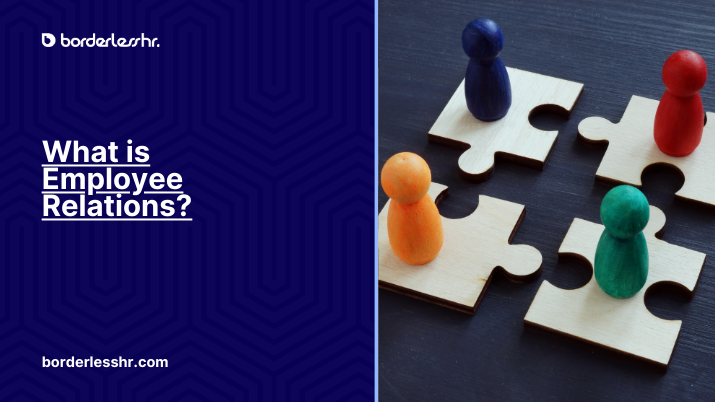An ideal work environment is a place where employees feel respected, heard, and valued. An environment that enables impersonal relations and trust between colleagues. This positive atmosphere is what strong employee relations are all about.
What is Employee Relations Management?
Employee relations are like a bridge between employers and employees. It’s about creating and maintaining a healthy work environment where everyone feels good about contributing to the company’s success. Let’s dive deeper and see how it works.
Why Employee Relations Management Matters
Think of your company as a team. Just like any sports team, you need strong relationships and open communication to succeed. ERM helps build that teamwork by:
Boosting Employee Engagement: Engaged employees are happy, productive, and less likely to leave. ERM creates an environment where people feel like they contribute and their voices are heard.
Reducing Conflict: Disagreements happen everywhere, but ERM equips you with tools to resolve them quickly and fairly. This minimizes drama and keeps everyone focused on the job.
Improving Retention: Happy employees tend to stay put. Strong ERM practices lead to lower turnover rates, saving you time and money on recruitment and onboarding.
Enhancing Employer Brand: Word travels fast. Positive employee experiences create a good reputation, attracting top talent and boosting your employer brand.
Benefits of Good Employee Relations Management
Think about it this way, happy employees are productive employees. When people feel good about their jobs, they’re more likely to go the extra mile. Strong employee relations lead to several benefits for both employers and employees:
Increased productivity and engagement: Happy employees are more focused and motivated, leading to better results.
Reduced turnover: Employees who feel valued are less likely to leave for another job. This saves the company time and money on recruitment and training.
Improved problem-solving: When employees feel comfortable communicating, issues can be addressed quickly and efficiently.
Positive employer brand: A good reputation for employee relations attracts top talent and improves the company’s image.
Stronger company culture: Positive employee relations foster a sense of teamwork, collaboration, and belonging.
Who’s Involved?
Employee relations is a collaborative effort. Here are the key players:
Employees: They’re at the heart of it all. Their well-being, satisfaction, and contributions are crucial.
Managers: They play a vital role in fostering open communication, addressing concerns, and creating a positive team environment.
Human Resources (HR): HR partners with managers to develop and implement employee relations policies, handle conflicts, and ensure compliance with labor laws.
Employee Representatives (if applicable): In some workplaces, unions or employee councils represent employees in collective bargaining and grievance procedures.
Key Areas of Employee Relations Management
Employee relations encompass various aspects of the work experience. Let’s explore some key areas:
Communication: Clear, two-way communication is essential. This includes keeping employees informed, listening to their feedback, and addressing their concerns promptly.
Performance Management: Setting clear expectations, providing regular feedback, and offering opportunities for growth and development are crucial for employee motivation.
Compensation and Benefits: Offering fair pay, competitive benefits packages, and recognition programs shows employees they’re valued.
Workplace Conflict Resolution: Disagreements happen. Having a clear process for resolving conflict fairly and constructively is important.
Work-Life Balance: Respecting employees’ personal time and promoting healthy work-life boundaries helps prevent burnout and fosters well-being.
Compliance with Labor Laws: Ensuring employees are treated fairly and following labor regulations is essential.
Actionable Steps to Building Strong Employee Relations
Here are some practical steps to nurture positive employee relations:
Develop a clear employee relations strategy: Outline your goals, policies, and procedures for communication, conflict resolution, and other areas.
Invest in open communication: Hold regular meetings, conduct surveys, and encourage open dialogue between employees and managers.
Recognize and reward employees: Celebrate achievements, big or small, to show your appreciation.
Promote work-life balance: Offer flexible work arrangements, encourage breaks, and respect employees’ time outside work.
Be fair and consistent: Treat all employees with respect and apply policies consistently to avoid feelings of favoritism.
Invest in employee well-being: Offer wellness programs, promote healthy habits, and create a supportive work environment.
Maintaining Strong Employee Relations
ERM is an ongoing process. Here are some tips to keep those positive connections strong:
Recognize and Reward Achievements: Celebrate individual and team successes. This motivates employees and shows them their contributions are valued.
Invest in Employee Development: Offer training programs and opportunities for career growth. This keeps employees engaged and helps them reach their full potential.
Show Appreciation: A simple “thank you” goes a long way. Recognize employee efforts and express gratitude for their hard work.
Be Flexible: Life happens. Consider flexible work arrangements like remote work options or parental leave to help employees manage their personal lives.
Common Employee Relations Challenges and How to Overcome Them
Employee Relations (ER) is all about creating a positive work environment where everyone feels happy and respected. But just like any relationship, things don’t always run perfectly. Here’s a look at some common bumps in the ER road and how to navigate them:
Communication Mishaps: Sometimes messages get lost or misunderstood. The key is clear and regular communication. Hold team meetings, have open-door policies, and encourage employees to speak up if they have concerns.
Conflict Resolution: Disagreements happen! The important thing is to address them promptly and fairly. HR (Human Resources) can help mediate conflicts and find solutions that work for everyone.
Feeling Unvalued: Everyone wants to feel appreciated. Make sure employees know their contributions matter. Offer recognition programs, provide opportunities for growth, and be fair with workloads and promotions.
Work-Life Balance Woes: Feeling burnt out isn’t good for anyone. Encourage employees to take breaks, use their paid time off, and set boundaries between work and personal life. Consider flexible work arrangements if possible.
Unclear Policies: Confusion about rules can lead to frustration. Make sure company policies are clear, easy to find, and applied consistently. Regularly review and update policies to reflect any changes.
By following these tips, you can create a stronger ER foundation. Remember, happy employees are productive employees, and that benefits everyone!
Conclusion
Employee relations are an ongoing process. By focusing on building trust, fostering open communication, and creating a positive work environment, organizations can reap the benefits of a happy and productive workforce.







